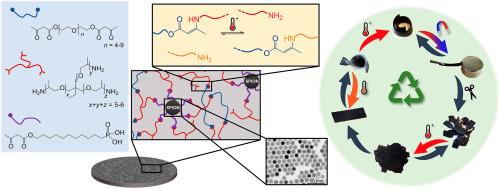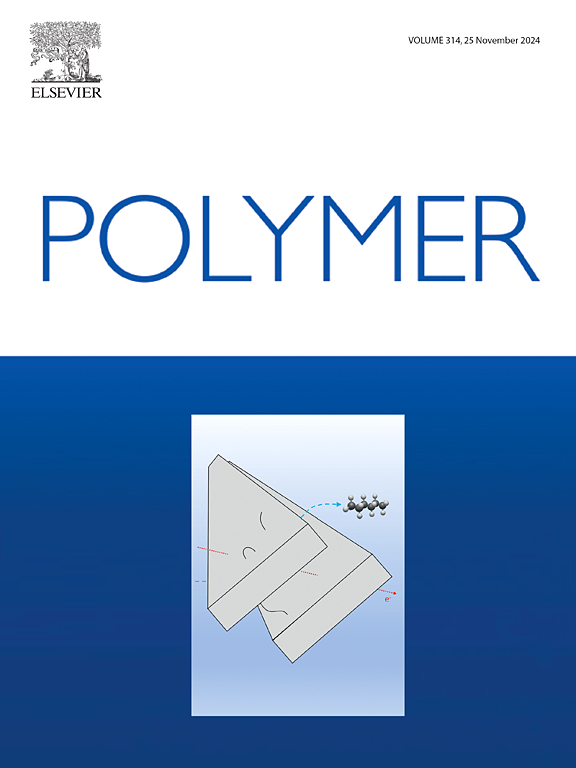超顺磁性氧化铁纳米粒子--玻璃纤维纳米复合材料:可再加工的多响应材料
IF 4.5
2区 化学
Q2 POLYMER SCIENCE
引用次数: 0
摘要
刺激响应软材料领域发展迅速,尤其是最近在磁性软材料的设计和制造方面取得了进展。磁响应弹性体在弹性体基体中加入了磁性颗粒,在磁场作用下表现出快速、可逆的驱动特性,因此非常适合开发柔性遥控软机器人。然而,传统的交联弹性体材料往往缺乏可回收性,也不具备与玻璃聚合物材料相关的多功能特性。玻璃体聚合物是一种动态交联聚合物,加热后可进行再加工,并具有可回收性和自愈性等宝贵特性。在这项研究中,我们在乙烯基聚氨酯玻璃聚合物基体中加入了 5 至 15 wt.% 的超顺磁性氧化铁纳米粒子 (SPION),开发出了玻璃聚合物纳米复合材料,这种材料同时具有热响应性和磁响应性。此外,一种带有膦酸锚定基团的新型乙酰乙酰化配体被用来修饰 SPIONs 的表面,从而提高其稳定性,并使其能够与玻璃聚合物基体共价连接。纳米粒子与基质的交联改善了机械性能,包括拉伸应力和应变的增加。由于纳米粒子是与基体共价结合的,因此可以在不影响 SPIONs 均匀分布的情况下对所得材料进行再加工和再循环,从而促进了再利用和再循环的闭环循环,同时保持了纳米复合材料的机械和磁性能。将 SPIONs 集成到乙烯基聚氨酯玻璃体中,开发出了稳定性和功能性更强的可持续先进材料,凸显了其在各种应用领域的潜力。本文章由计算机程序翻译,如有差异,请以英文原文为准。


Superparamagnetic iron oxide nanoparticle – vitrimer nanocomposites: Reprocessable and multi-responsive materials
The field of stimuli-responsive soft materials is rapidly evolving, particularly with recent advances in the design and fabrication of magnetic soft materials. Magnetically responsive elastomers, which incorporate magnetic particles into an elastomeric matrix, exhibit rapid and reversible actuation in the presence of a magnetic field, making them highly suitable for the development of flexible, remote-controlled soft robots. However, conventional crosslinked elastomer materials often lack recyclability and the versatile properties associated with vitrimer materials. Vitrimers, which are dynamically crosslinked polymers, can be reprocessed upon heating and offer valuable features such as recyclability and self-healing. In this study, we developed vitrimer nanocomposites by incorporating 5 to 15 wt% superparamagnetic iron oxide nanoparticles (SPIONs) into a vinylogous urethane vitrimer matrix, yielding materials that exhibit both thermal and magnetic responsiveness. Furthermore, a novel acetoacetylated ligand with a phosphonic acid anchoring group was utilized to modify the surface of SPIONs, enhancing their stability and enabling their covalent linking to the vitrimer matrix. The crosslinking of the nanoparticles to the matrix improves the mechanical properties, including increased tensile stress and strain. Since the nanoparticles are covalently bound to the matrix, the resulting material can be reprocessed and recycled without compromising the uniform distribution of SPIONs, thereby promoting a closed-loop cycle of reuse and recycling while preserving the mechanical and magnetic properties of the nanocomposites. The integration of SPIONs into vinylogous urethane vitrimers results in the development of sustainable advanced materials with enhanced stability and functionality, highlighting their potential across various applications.
求助全文
通过发布文献求助,成功后即可免费获取论文全文。
去求助
来源期刊

Polymer
化学-高分子科学
CiteScore
7.90
自引率
8.70%
发文量
959
审稿时长
32 days
期刊介绍:
Polymer is an interdisciplinary journal dedicated to publishing innovative and significant advances in Polymer Physics, Chemistry and Technology. We welcome submissions on polymer hybrids, nanocomposites, characterisation and self-assembly. Polymer also publishes work on the technological application of polymers in energy and optoelectronics.
The main scope is covered but not limited to the following core areas:
Polymer Materials
Nanocomposites and hybrid nanomaterials
Polymer blends, films, fibres, networks and porous materials
Physical Characterization
Characterisation, modelling and simulation* of molecular and materials properties in bulk, solution, and thin films
Polymer Engineering
Advanced multiscale processing methods
Polymer Synthesis, Modification and Self-assembly
Including designer polymer architectures, mechanisms and kinetics, and supramolecular polymerization
Technological Applications
Polymers for energy generation and storage
Polymer membranes for separation technology
Polymers for opto- and microelectronics.
 求助内容:
求助内容: 应助结果提醒方式:
应助结果提醒方式:


